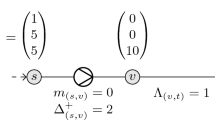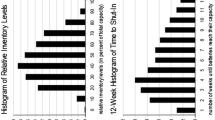Abstract
One of the many complex problems that arise from the transmission and marketing of natural gas is when a shipper draws a contract with a pipeline company to deliver a certain amount of gas among several points. What is actually delivered is often different from the amount that had been originally agreed upon. This phenomenon is called an imbalance. When an imbalance occurs, the pipeline penalizes the shipper by imposing a cash-out penalty policy. Since this penalty is a function of the operating daily imbalances, an important decision-making problem for the shippers is how to carry out their daily imbalances so as to minimize their incurred penalty.
In this paper, we introduce the problem of minimizing the cash-out penalty costs from the point of view of a natural gas shipping party. We present a mixed integer bilevel linear programming model and discuss its underlying assumptions. To solve it efficiently, we reformulate it as a standard mathematical program and describe a penalty-function algorithm functions for its solution. The algorithm is well-founded and its convergence is proved. Results of numerical experiments support the algorithm’s robustness providing a valuable solution technique for this very important and complex problem in the natural gas market.
Similar content being viewed by others
References
Bard JF (1998) Practical bilevel programming: algorithms and applications. Kluwer, Dordrecht
Brooke A, Kendrick D, Meeraus A (1992) GAMS: A user’s guide. The Scientific Press, San Francisco
Fukushima M (1992) Equivalent differentiable optimization problems and descent methods for asymmetric variational inequality problems. Math Program 53(1–3):99–110
Gendreau M, Marcotte P, Savard G (1996) A hybrid tabu-ascent algorithm for the linear bilevel programming problem. J Global Optim 8(3):217–233
Hearn DW (1981) The gap function of a convex program. Oper Res Lett 1(2):67–71
Himmelblau DM (1972) Applied nonlinear programming. McGraw-Hill, New York
Kalashnikov VV, Kalashnikova NI (1996) Solving two-level variational inequalities. J Global Optim 8(3):289–294
Marcotte P (1985) A new algorithm for solving variational inequalities with application to the traffic assignment problem. Math Program 33(3):339–351
Marcotte P, Dussault J-P (1989) A sequential linear programming algorithm for solving monotone variational inequalities. SIAM J Contr Optim 27(6):1260–1278
Marcotte P, Zhu DL (1996) Exact and inexact penalty methods for the generalized bilevel programming problem. Math Program 74:141–157
Migdalas A, Pardalos P, Värbrand P (eds.) Multilevel optimization: algorithms and applications. Kluwer, Dordrecht, 1998
Ríos-Mercado RZ (2002) Natural gas pipeline optimization. In: Pardalos, PM, Resende, MGC (eds.) Handbook of applied optimization, chapter 18.8.3. Oxford University Press, New York, pp. 813–825.
Author information
Authors and Affiliations
Corresponding author
Rights and permissions
About this article
Cite this article
Kalashnikov, V.V., Ríos-Mercado, R.Z. A natural gas cash-out problem: A bilevel programming framework and a penalty function method. Optim Eng 7, 403–420 (2006). https://doi.org/10.1007/s11081-006-0347-z
Received:
Revised:
Issue Date:
DOI: https://doi.org/10.1007/s11081-006-0347-z




